Should you acquire 50 or 100 backlinks? Will that be enough to rank your homepage or power page? Just how many backlinks will be enough? Find answers to these questions in this article.
Let’s dive straight into answering the question!
How Many Backlinks Do You Need to Rank Your Website?
Frankly, there are no definite backlinks to rank any web page. The numbers vary from one page to another, depending on your competitors’ average links.
Confusing, eh?
I’ll explain what I mean with these 2 examples below:
Heads up: I’ll use Ahrefs and Semrush for my backlink analysis. So, the screenshots will be from the SEO tools.
📌 Example 1:
Keyword: “how to make money online”

- Now, let’s see the top 5 results for the keyword.
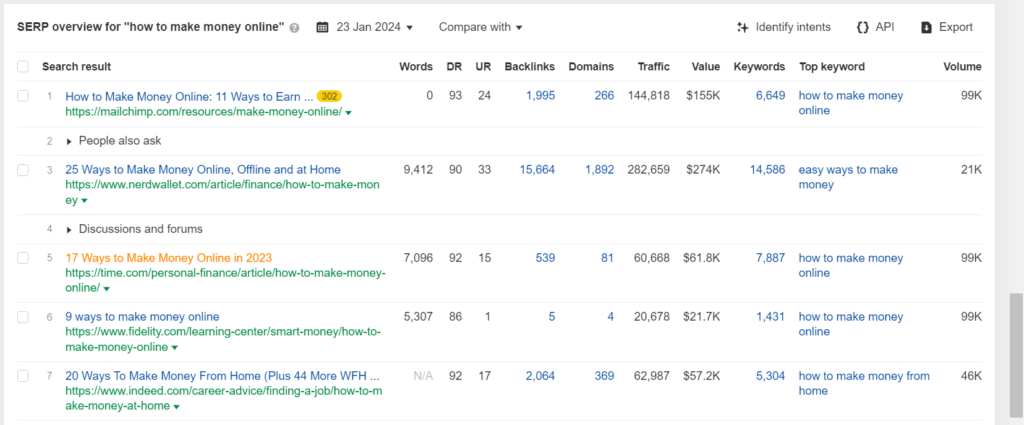
- Check the backlinks column
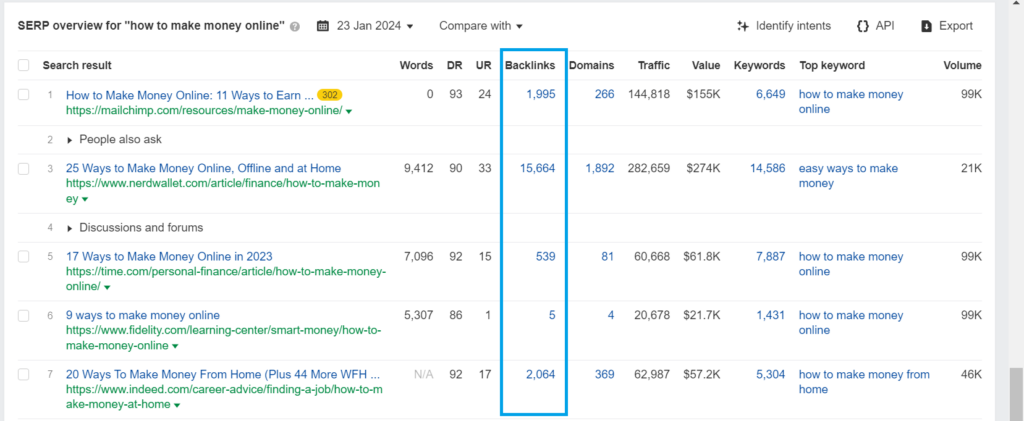
- Find the average backlink needed; that’s the minimum required to break into the top results in this case.
Note:
Exclude outliers like “fidelity” and “nerdwallet” from your calculation.

In summary, building 1533 more backlinks to equally high-quality content on “how to make money online” will get you into at least the top 10 results for the keyword.
📌 Example 2:
Keyword: “how much money can you make on Shopify”

- Let’s see the top 5 results for the keyword
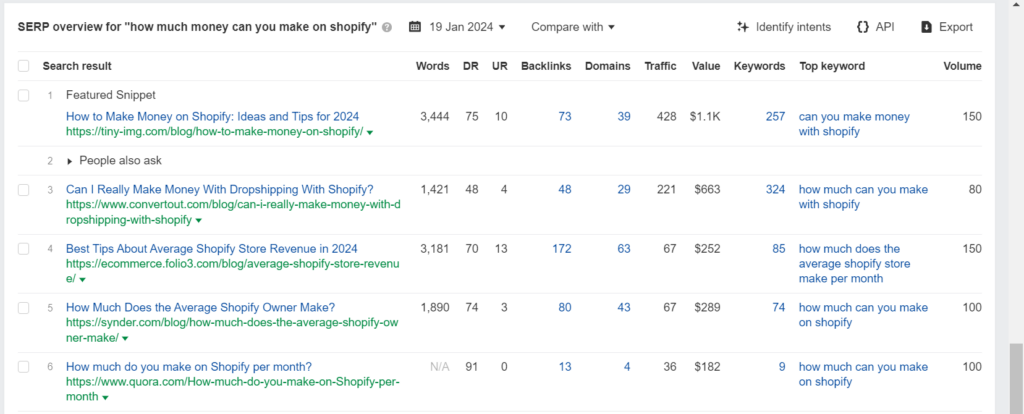
- Check the backlinks column
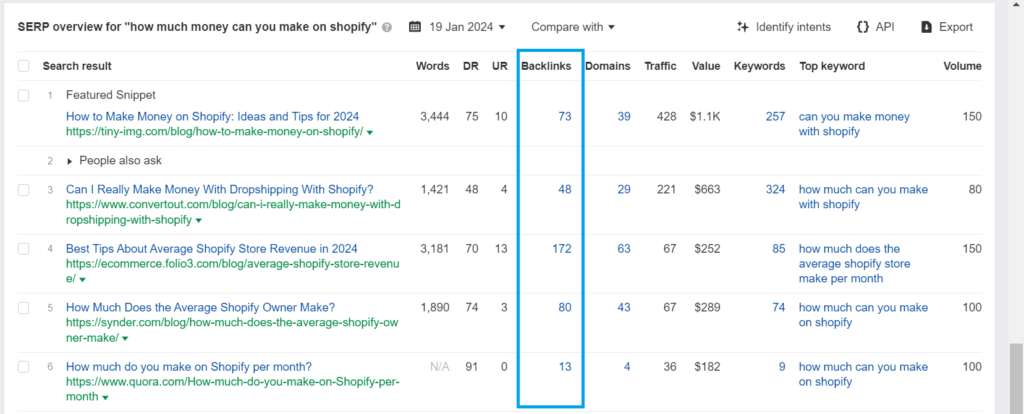
- Find the average backlink needed

In summary,
building 77 high-quality backlinks to equally high-quality content on “how much money can you make on Shopify” will get you into at least the top 10 results for the keyword.
Now, we have new sets of questions:
- Why are the base/average backlinks different for various keywords or websites?
- Why can’t you target 50 backlinks for your homepage and 100 backlinks for your powerpages/money pages — as advised by “SEO gurus”?
I only have a straightforward answer to both questions: there’s no standard backlink number to rank.
In my decade-plus of SEO work, I have learned that pursuing the same quantity of backlinks to rank all your pages doesn’t work.
The backlinks you need to rank your pages (home or power page) depend on a few factors.
Factors Determining the Backlinks Needed for Ranking
Here’s a quick preview of the factors:
- Your goal and the page
- Industry average and budget
- Keyword difficulty
- Domain authority
- Domain age
- Internal linking
Your Goal and the Page
The number factor that determines the backlinks needed to rank a webpage is the goal behind creating the page in the first place. So, revisit your objectives.
- What do you hope to achieve with your webpage?
- Will the page be strictly informational or transactional?
For example,
informational pages need fewer backlinks to rank (or none at all). You might only round up your customers’ pain points and write about them. This can work for SaaS companies and service/product-based businesses.
However, these pages don’t usually get lots of traffic — according to Ahrefs’ traffic study.
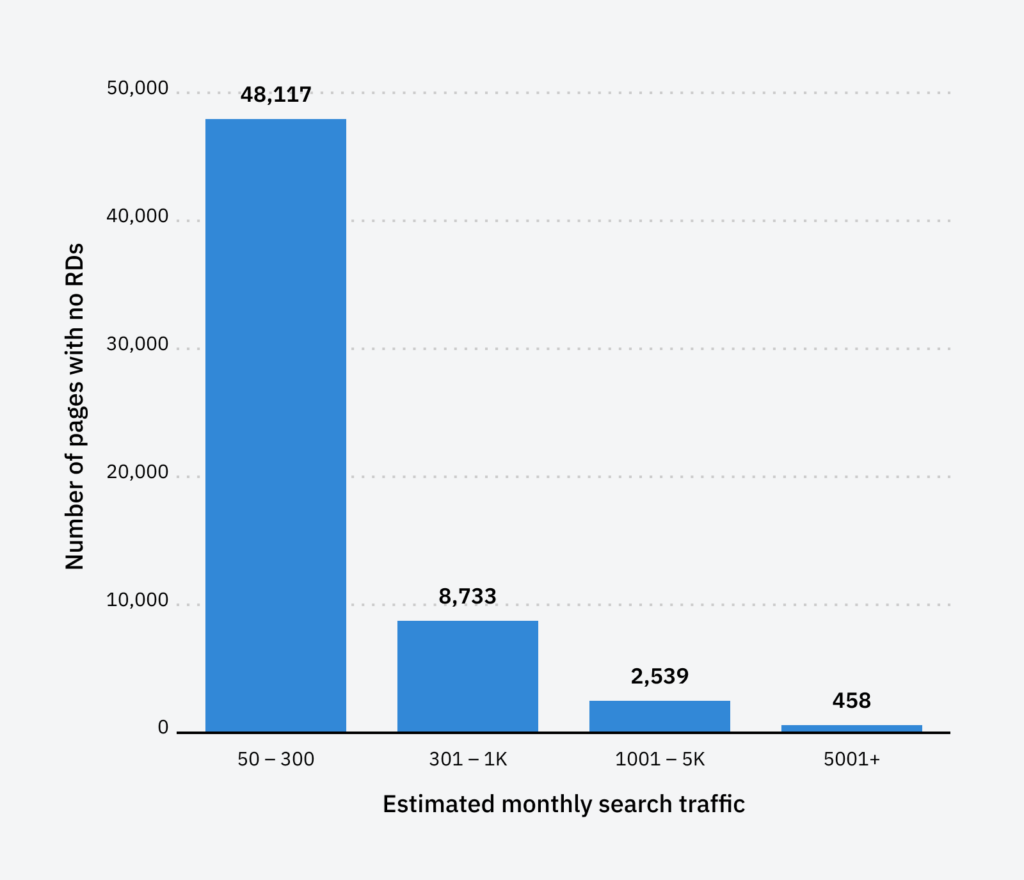
Transactional pages (like homepages and power pages), on the other hand, need backlinks. These pages will house your money keyword and drive leads & sales. As a result, ranking these pages will be competitive.
From experience, the higher the competition, the more you need to build backlinks.
Keyword Difficulty (KD)
KD is the degree to which it is easy or difficult to rank for a target keyword. It is graded on a scale of 0 to 100.
So, how is KD determined?
Simple: the backlink profiles of the sites ranking for a keyword influence “keyword difficulty score.”
In other words, if low-authority sites rank for a keyword, it (the keyword) will have a low difficulty score.

Ideally, such low keyword difficulty scores mean you only need a few backlinks — as seen in example 2. In some cases, matching user search intent (as shown in the screenshot) is all you need to rank.
The difficult keywords, on the other hand, will require a lot of backlinks — as seen in example 1.

You’ll need more than backlinks, top-notch content and on-page SEO to rank for these keywords.
Industry Average and Budget
Informational pages or not, easy-to-rank keywords or not, industry averages significantly influence the number of backlinks to target to rank a page. How so?
Like in our example earlier, the easiest trick to determine the number of backlinks to target is to check what your competitors are doing on search engines.
If people are linking to your competitors’ pages, their content must be compelling. Beyond that, how many people are sending these backlinks?
Then, find a way to improve both numbers. But while you’re at it, remember your budget. Link building can be expensive.

Bottom line:
rank your pages using the industry average, but remember your budget. In other words, chase the numbers you can afford.
Domain Authority (DA)
Like KD, DA is calculated on a scale of 0 to 100 and determined by the number and quality of a website’s referring domains.
Note:
DA is the same as DR (Domain Rating) and AS (Authority Score). The name changes depending on the tool you’re using.
What does DA have to do with the number of backlinks needed to rank a page?
Let’s split the question into two:
- Is DA a ranking factor?
- Why does it matter to the number of backlinks to target to rank your website?
Is DA a Ranking Factor?
It is proven without doubt that DA is not a ranking factor — Search Engine Journal. Yet, a correlation exists between DA and rankings — as revealed in the Backlinko study of 11.8M search results.
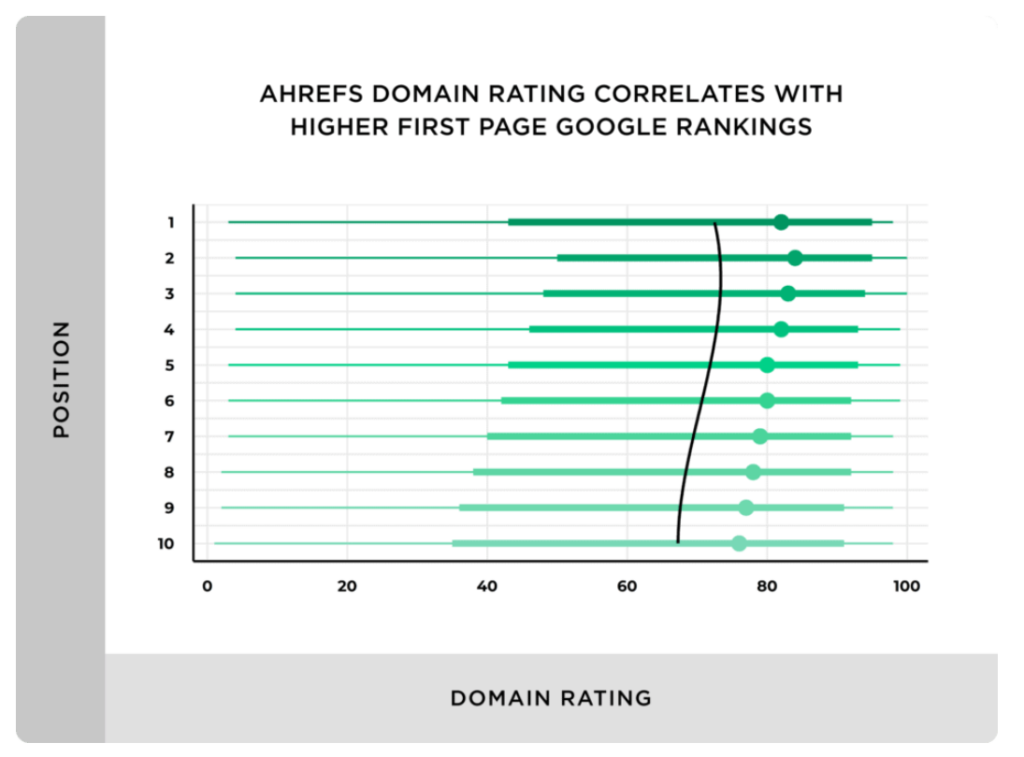
My take: domain authority shows that other websites find a piece of content valuable. By extension, their users will have the same feeling. In that sense, the latter will read more of the linked site’s content. Then, Google will rank the site’s content higher on search results.
Further reading: How to Increase Domain Authority
Why Does DA Matter to the Number of Backlinks to Target to Rank Your Website?
From examples 1 & 2, Mailchimp and Tiny-img are no 1 positions for their respective keywords. And they relatively have the least backlinks despite having the keywords with the most traffic and search volume.
The case of Mailchimp is even more interesting. Although the original page has been directed (the reason for “error 302”) to a new URL, it still ranks first.

Bottom line:
the higher your DA, the fewer links you’ll need to outrank competitors with lower DAs.
Domain Age
Like domain authority, domain/page age also influences the number of backlinks needed for ranking. The older a domain/page is, the higher its chance of ranking.
So, what can you do about the age factor? How can you level up with an older domain/page?
Use SEO competitor analysis to ascertain these details:
- First, check the organic birthdates of your competing pages. This will give you an idea of how long it will take to achieve your desired ranking.
- Lastly, and more importantly, analyze your competitors’ link acquisition velocity. This will tell you the number of backlinks needed per month.
Internal Linking
Internal linking does not reduce the number of backlinks to rank a page by itself. It depends on domain authority. How?
Internal links are like drainages. They create the pathway for link juice.
By interlinking your pages, you funnel authority from one page to another on your site. The idea is to circle link juice to all your web pages to increase their page authority.
In essence, each page will reflect your domain authority and carry the same weight and relevance on search results.
Bottom line:
when each of your web pages has high authority, you’ll require little to no backlinks to outrank competitors with low page authority.
While the attention has been on link quantity, note that is not all there is to rank a page. In fact, quantity is the least important thing to note. There are 10 more crucial elements to consider.
Looking Beyond Link Quantity: 10 Things to Consider
Here is a preview of the elements:
- Content quality
- Link placement
- Editorial merit
- Relevance of the linking page
- Authority of the linking page
- Backlink profile of the linking page
- The diversity of the linking pages
- Traffic
- Engagement
- Link velocity
Content Quality
While the position of backlinks as a ranking factor is contested, content significance to search rankings is undoubted. Often, well-written, authentic, and authoritative content will rank well — even for a competitive keyword.
In other words, regardless of whether you get the average backlinks needed to rank well, your content should be top-notch.
So, how can you produce high-quality content?
Let’s pick each of the underlined terms.
- Well-written content — this means writing relevant content that meets the user’s search intent. In addition, it means structuring your article the way users want it. For example, don’t write a review when readers need a listicle.
- Authoritative content — means adding expert opinions, insights, and in-depth data to your content. This adds authority to your content and, more importantly, reduces unnecessary fluff.
- Authentic content — this means displaying your brand personality in your content using unique & personal examples. More importantly, it means delivering on what is promised.
Link Placement
Adding backlinks to your content is a big deal, and where the link appears (HTML locations or link placements) is even more significant.
In other words, placing links anywhere on linking pages is not enough. Be specific about where you want it — as much as possible.
So, how can you get the “right” HTML locations for your backlinks?
- The easiest method is to write a guest post. Then, place your backlink wherever you see fit in the post — I recommend the placement is near the core points as much as possible. And follow guidelines. Otherwise, your post might be declined.
- Use niche edits — these can help you get high-quality backlinks on posts published on niche-specific sites. The most beautiful part is that these posts are live, with impressive traffic and engagement.
Beyond link placement, check the placeholders — also known as anchor text. As much as possible, prioritize “exact match anchors.” but you can mix them with phrase matches.
In any case, ensure you use a keyword-rich anchor text. And while at it, avoid naked/URL anchors.
Further Reading: How to Use Anchor Texts
Editorial Merit
In addition to where your backlinks are placed, how you get them is significant to ranking. This point is where building backlinks with editorial merit can help.
What is editorial merit?
This means building inbound links because of the value of your content rather than link spam techniques. In other words, high-quality websites link back to your content willingly because they see that your article, tool, or research can help their readers.
And interestingly, backlinks built via editorial merit carry the most weight.
Note:
link spam techniques won’t necessarily lead to a penalty or ban. But they don’t work and are not sustainable. In summary, they are a complete waste of time, effort, and money.
Relevance of the Linking Page
Relevance is the first of 3 crucial elements specific to the source of your link. It means the niche relationship between your site and your linking page.
- Are both sites in the same niche?
E.g., getting a backlink from a fashion website like Vogue as a fashion designer

- Are your sites in related niches?
E.g., acquiring a backlink from a lifestyle website like Martha Stewart as a fashion designer

In both cases, the backlink is relevant since there is a relationship between the linking site and the receiving page. As such, authority can trickle down from the former to the latter.
On the other hand, placing a backlink on Vogue to a roofing business won’t work. The two niches are not related. In this case, it won’t matter if you have 100 backlinks; the effects will be minimal — that’s if there are any effects.
Authority of the Linking Page
Authority is the second element specific to your linking page. It is just as significant as the page’s relevance. How so?
The link juice trickling down from a linking page is based on “perceived authority.” If there is no authority, nothing will be passed down.
Also, if the authority of a linking page is lower than that of your webpage, your site will not be boosted.
So, it’s a tricky situation. From experience, it is not enough that a linking page is relevant to your niche; it must be equally authoritative.
Now to the crucial question: how can you identify an authority page or website?
Short answer: use a domain authority checker!
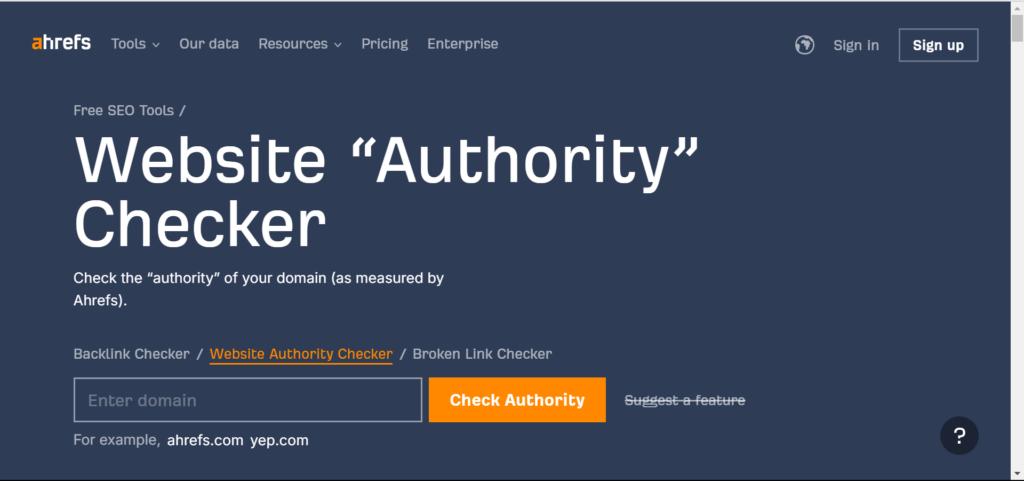
Bottom line:
target higher domain authority sites. But beyond the DA scores, manually confirm the quality of the content on the site.
More importantly, ensure that your linking page’s “page authority” is as high as the “domain authority.”
The Backlink Profile of the Linking Page
This is the third (and last) element specific to your link page. And it is all about trust.
Beyond the niche relevance and the high authority, can you trust the linking page? Will your money page be safe after the backlink?
The answer to these questions lies in analyzing the backlink profile of your link page. Check where they get their inbound links from. How?
Use Ahrefs Site Explorer!
Note: our sample site is Vogue.
- Go to Site Explorer > input the domain > backlinks
- Apply the “dofollow” and “backlink type” filters like this:
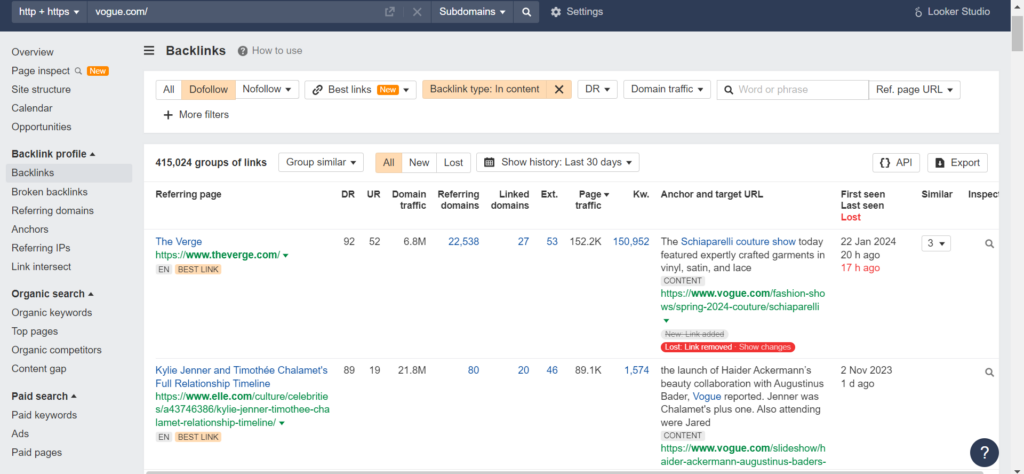
If you scroll down the list, you’ll find that all the backlinks are from similar niche sites with high domain authority. So, yes, incoming backlinks from this site are safe.
But before concluding, check the site’s outgoing links.
- Check the left tabs for “outgoing links.”
- Apply the “dofollow” filter and set the “link type” to “in content.”
- Then, filter links going to social media networks, stock image sites, and the same domain like this:

- Check the pattern of the outgoing links. This will increase your chance of getting a backlink.
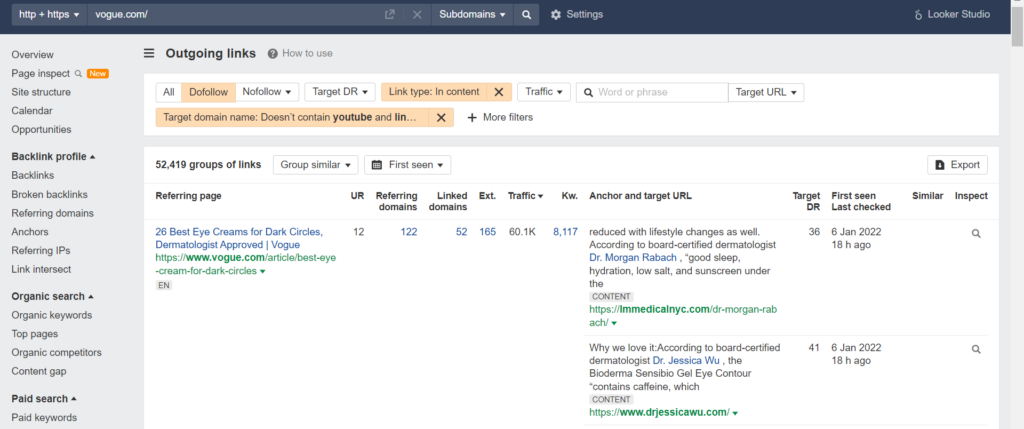
For our example (from this analysis), they (Vogue) like product recommendations and expert quotes.
The Diversity of the Linking Pages
Earlier, I mentioned that your backlink’s relevance, authority, and trustworthiness are just as significant as the number of backlinks pointing to your page/site — if not more.
Even at that, avoid the trap of only targeting exact-match anchor backlinks or the domains with the highest DA. It doesn’t work that way.
Here is why:
A natural backlink profile won’t have links with the same anchor type or DA scores. There will be variance in the anchor texts, DA, and even the relevance of the linking pages. Otherwise, your site/page will appear doctored and be flagged as spam by Google’s search engine crawler(s).
Bottom line:
build a mix of backlinks to your site — using direct and indirect relevance, high and medium DA scores, and different anchor types.
Traffic
Understandably, link builders focus more on authority, relevance, and trustworthiness. Beyond those three crucial elements, you should also consider the organic traffic of your target linking pages.
Whether high or medium DA, a backlink from a site that generates tons of search traffic will skyrocket your rankings and sales. The greater the traffic, the more your reach and conversion power.
That said, is there a baseline traffic to target? More importantly, how can you check?
- I recommend targeting sites or pages with at least 1K monthly organic traffic.
- About tools, you can use either Ahrefs or Semrush. Alternatively, you can try the free Chrome extension: Keyword Surfer.
Engagement
Like the domain authority, traffic can be doctored. The best way to access and confirm if the organic traffic is an in-depth analysis of traffic sources and engagement. How?
Unfortunately, there is no standard method for proving or disproving the authenticity of search traffic. Nevertheless, you can use SimilarWeb. Here is how:
- Going via the Similarweb URL is a long stretch as you would need to sign up and provide personal details
- Instead of that, install the Detailed SEO Extension on your Chrome
- Now, visit the target URL you’d love to analyze (we’re using Vogue) > click the Detailed SEO > Advanced > SimilarWeb
- Look towards the tabs on the left > marketing channels
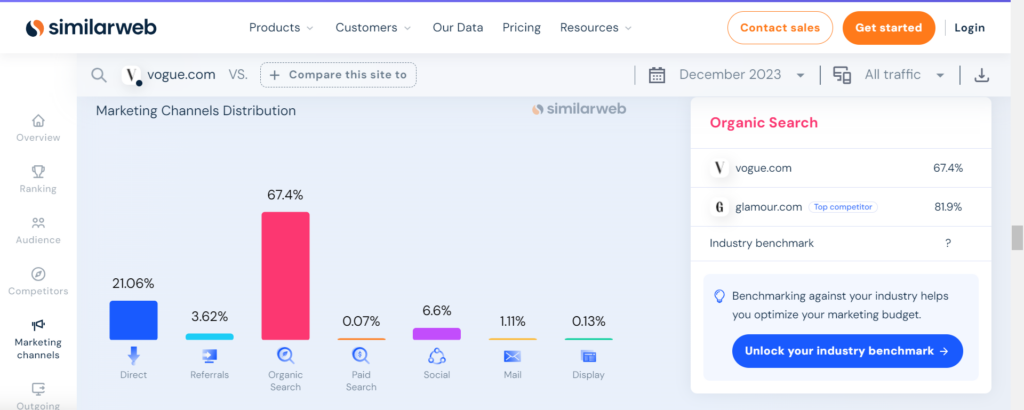
Note: “direct” distribution means sending links to people to visit your site, and it can be used to doctor traffic.
Bottom line:
if a target linking page’s traffic source is from “direct” more than “organic search,” don’t use it.
Link Velocity
Now, you know the backlinks that meet all the standards. But even now, one factor can affect your SEO efforts. It is the rate at which you gain backlinks — link velocity.
Link velocity is often considered a complex factor. But it isn’t. It is simply the number of links/referring domains acquired monthly.
By that definition, you need to maintain consistent link velocity. You can’t acquire hundreds of backlinks this month and none the following two months. Spread it out.
Aim for an optimal link velocity where you gain or lose links healthily like this:
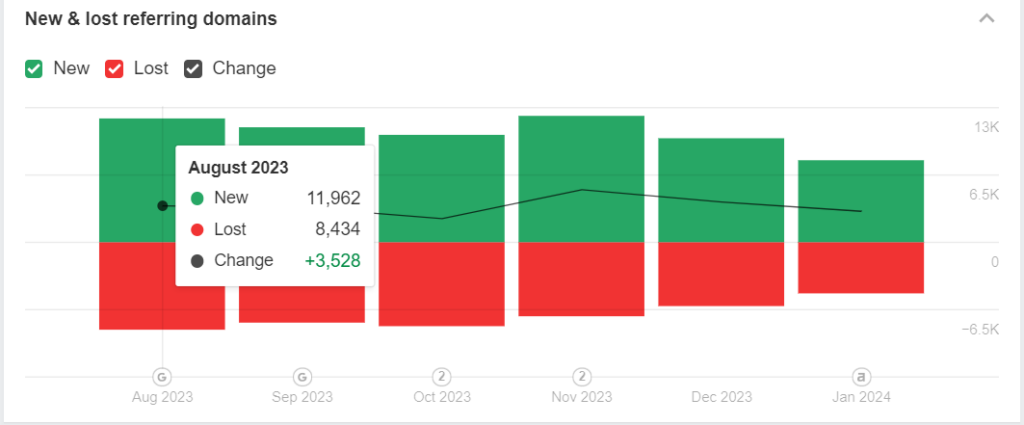
With everything discussed, it would seem link quality is more quantity. But is it?
Are Quality Links Better Building Numerous Backlinks?
My take: don’t focus solely on quantity when it comes to link building; prioritize quality.
Should you only build one authority backlink to your homepage and power pages?
No!
A single backlink won’t increase your search rankings depending on your competitors. Whether there is low competition or not, I recommend combining quality and quantity when building backlinks.
In other words, build high-quality backlinks at scale. But how?
How to Build High-Quality Backlinks at Scale
The best way to build quality links at scale is to do it systematically. I recommend following these three steps:
- First, determine the individual web page that needs backlinks
- Second, calculate the link gap
- Lastly, invest in white-hat link building strategies
Determine the Individual Web Page That Needs Backlinks
For starters, find your keywords ranking in the top 100 positions (first 3 pages on search engine results pages).
- Go to Ahrefs > Site Audit > Create a new project
- Then, crawl the site > “rank tracker,” and you’ll see a page similar to this:
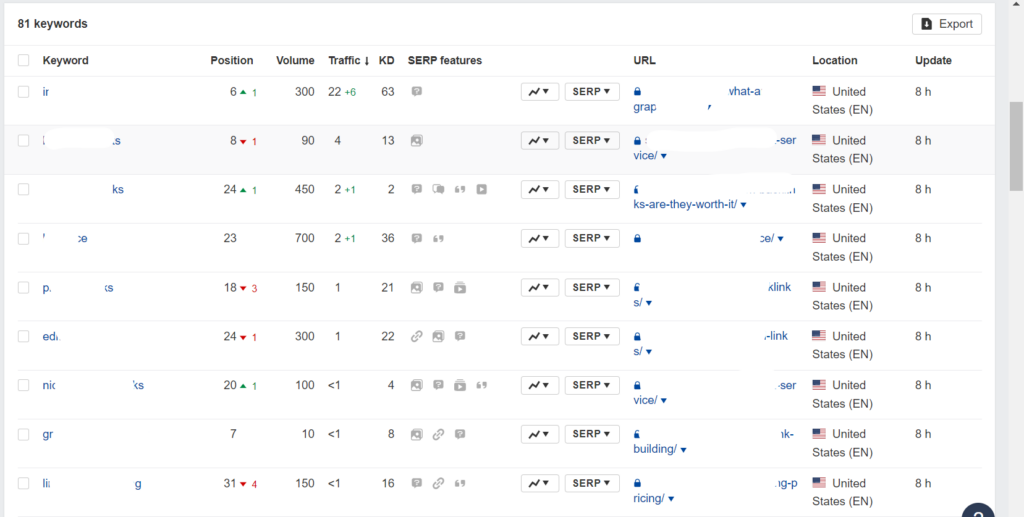
Alternatively, you can use Google Search Console
- Go to GSC > search results > queries > position
Either way, compile the keywords most likely to result in sales — i.e., “transactional keywords.” Also, ensure they have low “keyword difficulty scores.”
Calculate the Link Gap of the Page
This step is exactly the same as the one we took at the start of this article. The only difference is the streamlining.
- Type your low KD keywords into Keyword Explorer
- Find competitors with similar DR ranking in the first 10 search results
- Check the backlink gap and note it
Invest in White-Hat Link Building Strategies
What you’re doing here is closing the backlink gap between you and your competitors. But you can’t use any strategy.
Focus on a safe, natural link building strategy such as:
- Guest posting
- Build linkable assets
- Explore broken links
- Press Release link building
- Launch targeted link outreach campaigns
Summary
Whether homepage, money page, or power page, no definite or standard number of backlinks is needed to rank a webpage.
What you need depends on your competitors. In other words, find the link gaps between you and your competitors.
Furthermore, look beyond numbers. Check for link relevance, authority, and trustworthiness to generate high-quality incoming links.
Overall, combine quality and quality when building links. This is the most sustainable way to get and scale SEO success.
FAQs
How Many Links Do I Need per Month?
There is no standard number of backlinks to target per month. But even at that, only build some of your backlinks at a time; spread them out to cover your link building campaigns.
This way, your campaign will look natural, and you’ll achieve optimal link velocity.
How Can I Increase My Backlinks Fast?
There are two ways to increase backlinks fast:
- Niche edits — if you are going through the DIY route
- Hire a link building agency — this is the safe and hands-off
Can Too Many Links Hurt SEO?
No!
The quantity of your backlinks won’t hurt your SEO efforts. The quality, on the other hand, might.
In essence, focus on building only high-quality backlinks. However, ensure they are diversified and added with an optimal link velocity.

